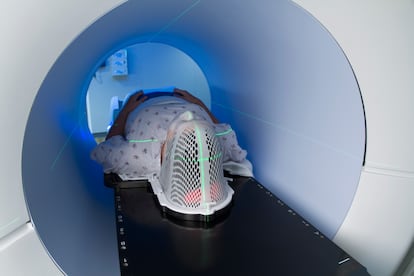New study reveals the first signs that nanoplastics harm human health
Patients with microscopic plastics in their arteries multiply their risk of myocardial infarction, stroke and death by 4.5

In recent years, there has been evidence indicating that nanoplastics are capable of entering breast milk, the placenta and blood plasma, as well as accumulating inside cells. Although some animal studies suggested that these ubiquitous particles could have health effects, there was a lack of analysis that pointed to this link in humans. However, this changed this week after the publication of an article in The New England Journal of Medicine.
A team led by Raffaele Marfella, from the University of Campania (Italy), analyzed 257 patients who went to three hospitals in the Naples region to undergo a surgical procedure to treat the accumulation of atherosclerotic plaques in the carotid artery, in the neck. This buildup can cause clogged arteries, which increases the risk of cardiovascular problems. Those responsible for the study took samples of these plaques and analyzed the presence of microplastics and nanoplastics. Their results show that 58% of the patients had traces of these plastic particles and, after monitoring those who had them and those who did not, they noted that, in the case of those who did, the accumulated risk of dying from any cause, myocardial infarction and stroke multiplied by 4.5.
“It is a conclusive result that opens a new vision about the pollutants to which we are exposed and don’t see,” says Jaume Marrugat, a researcher at the Hospital del Mar Medical Research Institute in Barcelona, who did not participate in the study. Although the results do not establish a cause-and-effect link, there are clear factors that point in that direction. Inflammatory biomarkers, which show the body’s response to what it considers a threat and increase the risk of heart disease, were higher among those with nanoplastics in the carotid. “This study highlights the importance of inflammation in arteriosclerosis, because we are used to thinking about cholesterol or hypertension as risk factors that produce this deterioration, but they are all inflammatory processes, like the one that nanoplastics have shown to cause,” says Enrique Gutiérrez, a cardiologist at the Gregorio Marañón University Hospital in Madrid. Furthermore, “the carotid is an artery and the heart is also irrigated by arteries, the coronary arteries, so we can infer that what happens in the carotid will also happen in the coronary artery,” concludes Marrugat.
Other studies have found that those who are exposed to plastic pollution at work have a higher risk of suffering from cardiovascular diseases. Animal models had also shown how nanoplastics, after being ingested or inhaled, are easily distributed throughout the body through the bloodstream and accumulate in well-irrigated organs, including the heart.
The study was carried out with a relatively small number of patients, and the authors themselves admit the possibility that the samples they used may have been contaminated. However, if confirmed, the results are troubling. Nearly 400 million tons of plastics are produced each year for products that can be found everywhere. A recent study published in the journal PNAS showed that approximately 250,000 plastic nanoparticles could be found in each one-liter plastic bottle. In addition, the particles that are released by a water bottle when it gets warm, or when the cap is opened and closed, can continue to divide to almost infinity. The team led by Marfella observed that most of the particles detected were below 200 nanometers and that, the smaller the size, the easier it is for them to colonize organs or even cells.
In a relatively new field of study, there are still important unknowns. The researchers saw no differences in the presence of nanoplastics in patients living in different regions. “We have no hypotheses at this time [regarding why some patients accumulate nanoplastics in their atheroma plaques and others do not], but we are preparing larger studies to explore the association between exposure to plastics and the accumulation of micro- and nanoplastics in the tissues,” says Francesco Prattichizzo, a researcher at IRCCS MultiMedica and co-author of the study.
These future studies will also serve to understand the weight of nanoplastics compared to other risk factors. As the authors of the study point out, in the last decades, at a time in which the population’s exposure to plastics has greatly increased, the prevalence of cardiovascular diseases has actually decreased.
New analysis techniques have made it possible to detect the presence of plastics in places where it used to be unthinkable, and now the different types of particles that can accumulate in the body can be identified. That way it will be possible to know their origin, the different risks posed by each type of particle and what preventive measures can be established in the face of what could be a global health problem, if results such as those published by the Italian team are confirmed. If microplastics and nanoplastics pose a significant health problem, then the use of a material that can remain in the environment for centuries, that in most cases has a single use and of which only 9% gets recycled, will have to be reassessed.
Sign up for our weekly newsletter to get more English-language news coverage from EL PAÍS USA Edition
Tu suscripción se está usando en otro dispositivo
¿Quieres añadir otro usuario a tu suscripción?
Si continúas leyendo en este dispositivo, no se podrá leer en el otro.
FlechaTu suscripción se está usando en otro dispositivo y solo puedes acceder a EL PAÍS desde un dispositivo a la vez.
Si quieres compartir tu cuenta, cambia tu suscripción a la modalidad Premium, así podrás añadir otro usuario. Cada uno accederá con su propia cuenta de email, lo que os permitirá personalizar vuestra experiencia en EL PAÍS.
¿Tienes una suscripción de empresa? Accede aquí para contratar más cuentas.
En el caso de no saber quién está usando tu cuenta, te recomendamos cambiar tu contraseña aquí.
Si decides continuar compartiendo tu cuenta, este mensaje se mostrará en tu dispositivo y en el de la otra persona que está usando tu cuenta de forma indefinida, afectando a tu experiencia de lectura. Puedes consultar aquí los términos y condiciones de la suscripción digital.
More information
Últimas noticias
There is as much life left to discover on planet Earth as that which is already known
Dozens presumed dead, around 100 injured in fire at Swiss Alps bar during New Year’s celebration
Is porn for women different from conventional porn? We spoke to those who make it
Cartagena de Indias is sinking: What can the city do to mitigate it?
Most viewed
- Reinhard Genzel, Nobel laureate in physics: ‘One-minute videos will never give you the truth’
- David King, chemist: ‘There are scientists studying how to cool the planet; nobody should stop these experiments from happening’
- Sinaloa Cartel war is taking its toll on Los Chapitos
- Oona Chaplin: ‘I told James Cameron that I was living in a treehouse and starting a permaculture project with a friend’
- The Interoceanic Train, the Mexican alternative to the Panama Canal











































